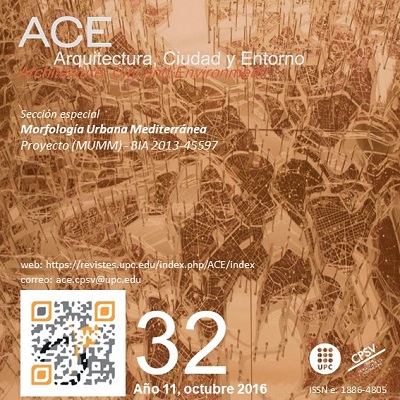Petites zones verdes per l'estalvi energètic: efectes sobre diferents assentaments urbans
DOI:
https://doi.org/10.5821/ace.11.32.4659Paraules clau:
Distància de refredament, àrees verdes, densitat construïda, estalvi energètic.Resum
Els aspectes de la sostenibilitat, fins avui, emergeixen com un tema central dins de la gran quantitat de definicions existents d'Smart City. En el debat actual, la conciència de que les TIC és una de les eines, però no la clau pel nou disseny urbà, especialment d'acord amb les noves exigències per satisfer les necessitats del present sense comprometre la capacitat de les generacions futures per satisfer les seves pròpies necessitats, col·locades a la part superior dels desafiaments globals cada vegada més opressius (canvi climàtic, energia, ús del sòl, etc.). Un dels objectius de la sostenibilitat urbana sembla estar en contradicció amb un dels punts principals del model d'Smart City: la necessitat de densificar la ciutat, a causa del ràpid creixement de la població. Si les ciutats estan dissenyades per ser més compactes, per optimitzar l'ús del sòl, com podem evitar el risc de col·lapsar la ciutat?
Una possible resposta pot venir de l'estudi de la relació entre els espais urbans plens i buits; els edificis, per un costat, i els espais oberts per l'altre. L'equilibri entre aquests espais ha de ser estudiat amb la finalitat d'orientar les polítiques i intervencions per la correcta localització, mida i disseny dels sistemes d'espais verds, en relació al consum d'energia, confort ambiental i els efectes positius de la reducció de CO2. Aquesta contribució presenta els primers resultats d'un estudi destinat a determinar les dimensions espacials, valors d'umbral verds, que influeixen al microclima urbà baixant les temperatures, i les seves distàncies de refrigeració, en relació amb diferents valors de densitat d'assentament de la trama urbana.Descàrregues
Publicades
Número
Secció
Llicència
| CRITERIS DE PROTECCIÓ INTEL·LECTUAL |
En aquest moment es compta amb la protecció de la Oficina Espanyola de Patents i Marques, mentre que la protecció global s'està tramitant davant la Organització Mundial de la Propietat Intel·lectual (OMPI/WIPO). Així mateix, la Oficina del Número de Sèrie Estàndar Internacional (ISSN) ha otorgat els següents números: 1886-4805 (versió electrònica) i 1887-7052 (versió en paper). |
| COPYRIGHT |
El contingut dels articles i els comentaris en ells expresats són responsabilitat exclusiva dels seus actors, i no reflexen necessariament la opinió del Comité Editor de la revista. Els treballs publicats per ACE queden sotmesos a la llicència CC BY-NC-ND 3.0 ES http://creativecommons.org/licenses/by-nc-nd/3.0/es/ La qual cosa vol dir que les persones autores només tenen i retenen els drets d'autor dintre de les limitacions imposades per la anterior llicència |





































